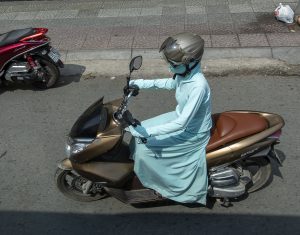Vietnam experienced its hottest day ever this month. The mercury rose to 44.1 degrees Celsius in Thanh Hoa province on May 6. A climate expert in Hanoi called the temperature high “a worrying record.”
Shorts and tank-top weather? Not quite. People on the streets of Hanoi or Ho Chi Minh City had bundled up from head to toe.
Vietnam was coping with extreme heat like it was an Arctic winter.
Cold-weather wardrobe staples like hooded sweaters, quilted jackets, blankets, and elbow-length gloves were a common sight. Some scooter drivers layered their faces with multiple masks or cloth veils held in place with sunglasses. Super-diligent sun avoiders topped off their outfit with a “covering garment” akin to an oversized kitchen apron. A media report on an April heatwave read like the description of a winter squall: “Jackets, face masks, and umbrellas are now commonplace on the street as people try to defend themselves from the sun-storm.”
Extreme layering for hot weather is not a new phenomenon in Vietnam. But “the look” has become more noticeable in recent years as average temperatures have risen. According to the news website TheSmartLocal Vietnam, the trend began a decade ago among women motorists: “It first started with a face mask to prevent sun exposure and pollution, and then a protective jacket to cover the arms. A few years later, stores started selling long protective skirts that cover the legs, and more and more people sought to cover themselves from head to toe to make sure no body parts could be reached by the sun.” The heavily swathed road warriors were dubbed “street ninjas.”
The fad has been widely mocked but also celebrated through memes and songs. In 2020, the street look went upscale when French fashion house Louis Vuitton launched a line of ninja-inspired clothing. Online shoppers were amused. “I want to buy this outfit for my mother to wear while commuting,” wrote one Facebook user.
In Vietnam, clothes are the preferred means of sun protection. Topical sunscreen use is less widespread. A 2018 study conducted at the National Hospital of Dermatology in Hanoi found that a “sunscreen coat” and “sunscreen trousers” were among the most widely used items for blocking ultraviolet (UV) radiation. Nearly 90 percent of all men and women surveyed wore a sunscreen coat. Online vendors like Shopee and Lazada carry a range of “sun protection” clothing made with UV-absorbing fabric. Skin cancer risk is low in Vietnam compared to other countries. The main reason for covering up is cosmetic rather than health-related.
Over-zealous layering has its downside. Sun-protective garments that impair visibility and movement can lead to road accidents. “When the garment becomes entangled and a driver falls suddenly on a major road, large trucks and passenger vehicles could be passing by, and the accident could become a serious one,” said a Hanoi traffic official who sees several garment-related accidents every summer.
Dashcam footage of mishaps and crashes has been shared on social media by fellow motorists. However, some feel the online trolling may have gone too far. “The problem of the ‘ninja scooter’ jokes is that they have drifted away from the original issue of the funny outfit and evolved to target women and eventually condemn their driving skills as a whole,” complained a member of a Facebook page that monitors online gender discrimination.
The “street ninja” outfit also has cheerleaders who applaud its unorthodox approach to sun protection. “As Vietnam often experiences days with a UV index of 11 or above, capable of burning the skin or eyes within 10 minutes of exposure, it is easy to see the head-to-toe covering outfits donned by commuters as more sensible than outlandish,” wrote one Ho Chi Minh City resident.
Vietnam’s “street ninjas” are on the frontlines of climate change. Their quirky summer dress code is a creative adaptation to global (and local) warming. Plus, it takes grit to wear layers on a hot day.

































